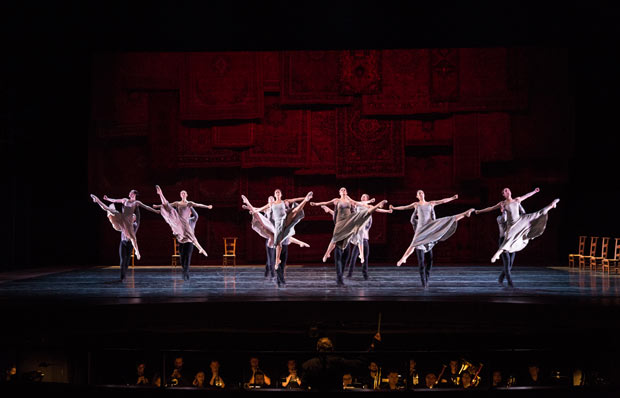
© Rosalie O’Connor. (Click image for larger version)
Juilliard Dance
Juilliard Dances Repertory: Roses, Moves, Symphony of Psalms
★★★✰✰
New York, Peter Jay Sharp Theater
24 March 2016
www.juilliard.edu
www.symphonyspace.org
An Evening at Juilliard
Juilliard has everything: a beautiful building full of spacious, well-lit studios, excellent faculty, a state-of-the-art theater, student orchestras of every stripe – classical, jazz, early music – and opera productions that rival those of many professional companies. Does it come as any surprise, then, that its dance program can put on a convincing evening of works by important twentieth-century choreographers, accompanied by live orchestra and even, in one case, by a large chorus? Well, it shouldn’t.
Twice a year, Juilliard Dance puts on a big show. In one of these, it focuses on dances of a certain vintage, of the type often referred to as “masterworks.” The other consists of dances created or adapted for the students by choreographers currently active on the scene (i.e. potential employers). In fact, one of the best, most touching performances I ever saw of Martha Graham’s Appalachian Spring was at a Juilliard performance. The dancers are young, but already skilled. They’re well trained, well-rounded. But they don’t yet have strong artistic personalities. That can be a good thing, as it was in that Appalachian Spring. It was like seeing the piece for the first time, scrubbed clean.
Tonight’s performance of older repertory contained no such revelations, but it was, as always, solid. The works – Paul Taylor’s Roses, Jerome Robbins’s Moves, and Jiri Kylian’s Symphony of Psalms – were all worth revisiting, different enough from each other to keep the audience interested. The music, by Wagner and Heirich Baermann (in Roses) and Stravinsky (in Symphony of Psalms) was played with verve by the Juilliard Orchestra under the baton of George Manahan. The clarinetist featured during the central pas de deux in Roses, Shen Liu, was particularly good. The chorus, too, acquitted itself well in Symphony, though a bit more intensity of feeling would have been welcome.
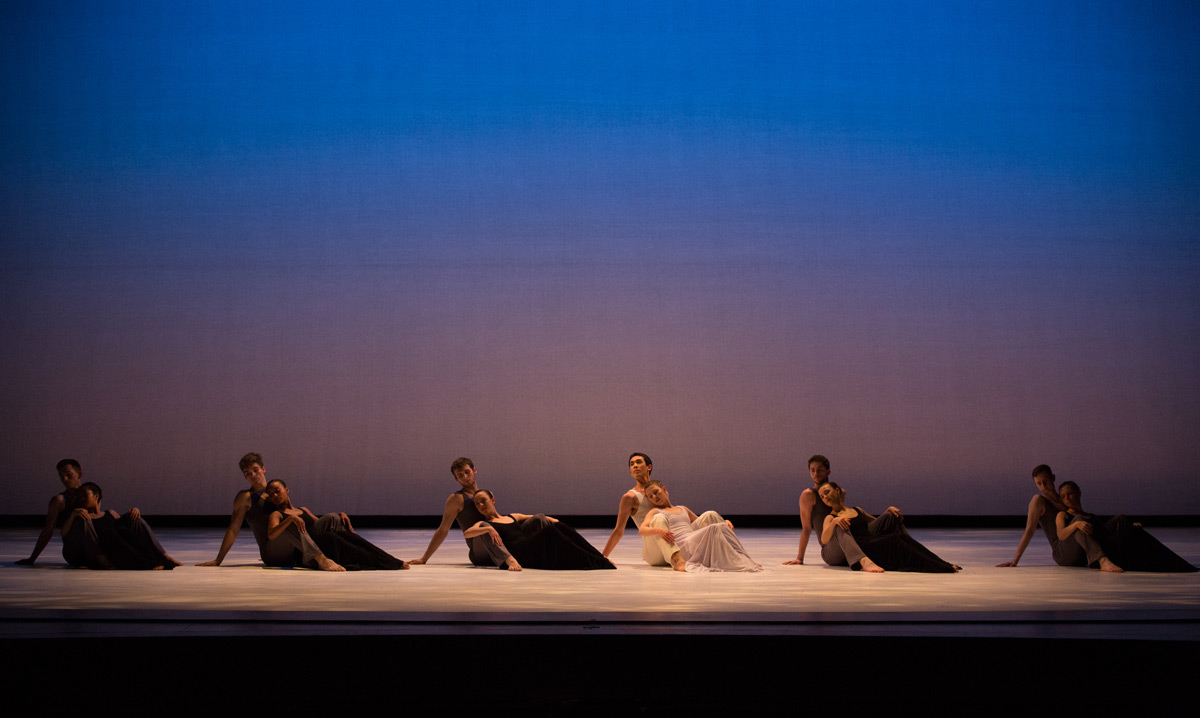
© Rosalie O’Connor. (Click image for larger version)
In terms of style, it seemed to me that Taylor’s Roses suffered the most out of the three works. There is something elusive about Taylor’s style, something that is often lost when his works are performed by non-Taylor dancers. Taylor’s company has a particular look: the men are big, muscular lugs, and the women (mostly) petite powerhouses, soft on the outside but rock-solid under the surface. The alchemy of the two – watching these big football-player types move with cat-like softness or fall to the ground with a loud thud – helps to define the shape and feel of a Taylor dance. The Juilliard dancers are less distinctive. They’re young, athletic, of medium build – it makes the movement look a bit generic.
Or maybe it’s the piece itself. Roses, set to Wagner’s Siegfried Idyll and a slow movement for clarinet by Baermann, is a gauzy ode to love that seems to take place behind a veil of comforting softness. Five couples caress and gambol, lean and tilt into each other, and fold themselves into each other’s protective embrace. The dance floats along, only vaguely tied to the music, until finally a sixth couple, dressed in white, saunters on and dances a truly lovely pas de deux. Unlike the others, this one hews closely to the music – particularly the clarinet melody – and reflects a more nuanced, less saccharine intimacy. The choreography flows from a kind of box step into a sustained, lilting phrase that pulls the dancers into corkscrewing lifts and falls. Meanwhile, they gaze constantly into each other’s eyes, as if caught in an endless conversation. The lead couple, Jesse Obremski and Cleo Person, danced it with fluent simplicity, and a sense of quiet understanding.

© Rosalie O’Connor. (Click image for larger version)
Robbins’ Moves is an anomalous work in that it has no music, and is instead accompanied by the sounds made by the dancers’ bodies: slides and thumps and slaps and thuds, as well as the dancers’ breath as they begin to tire. (And, unfortunately, the inevitable coughing and sneezing and vibrating of cell phones.) Though it’s danced on pointe, it’s one of the novelty pieces Robbins created for his touring group Ballets: U.S.A. in the fifties, and it feels a little like a sampler. If you look closely, you can see a jump from West Side Story, jazz hands from NY Export: Opus Jazz, a frieze-like shape he would use later in Antique Epigraphs, even some subtle echoes of The Cage. (Not to mention references to Balanchine works like Agon.) One of its more remarkable aspects is the way Robbins could accentuate a transition between a beautiful, balanced, harmonious pose, and an awkward, twisted position. It’s also self-consciously experimental, a hodge-podge of ideas and variations on those ideas. In one section, several couples partner each other; after a moment one realizes that a few of the dancers are actually going through the motions on their own. It’s as if their partners had suddenly disappeared into thin air. It’s clever, perhaps too clever.
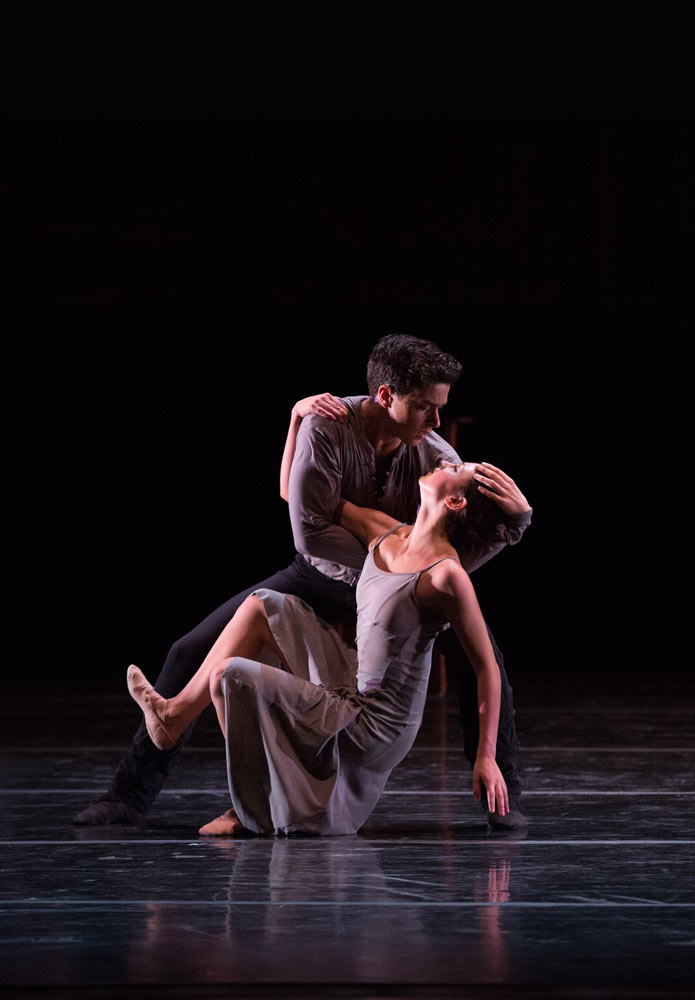
© Rosalie O’Connor. (Click image for larger version)
Kylian’s Symphony of Psalms, an early work, closed the evening. Stravinsky’s choral setting of three psalms is dominated by a grand, complex central fugue. The stage is spare and somberly lit. A row of chairs lines the back and one side. A backdrop of hanging Oriental carpets further delimits the space. (Why carpets? Who knows.) The dancers, plainly dressed, are like supplicants. They fall to their knees and lean on each other for support. As is often the case with Kylian, folk dance is a strong influence, particularly in the low, heavy movements for the women. The men traverse space with masculine, throbbing power. Religious images abound: shuffling on the knees, a pietà, arms held out as in a crucifixion. In the end, as the chorus sings Aleluia!, the dancers walk, haltingly, into the darkness. It’s all a bit obvious but effective enough in its sparseness and solemnity. Kylian’s dance is also well suited to young dancers, as its plain, grounded style doesn’t require much individuality. In fact, the more objective and neutral the dancers, the more “universal” the piece begins to feel.












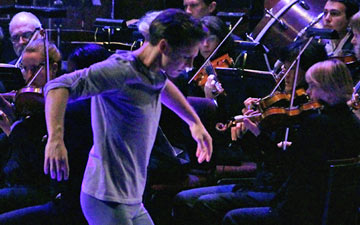
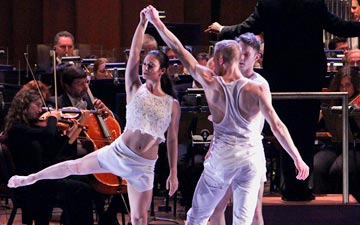
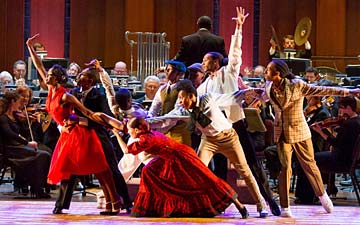


You must be logged in to post a comment.